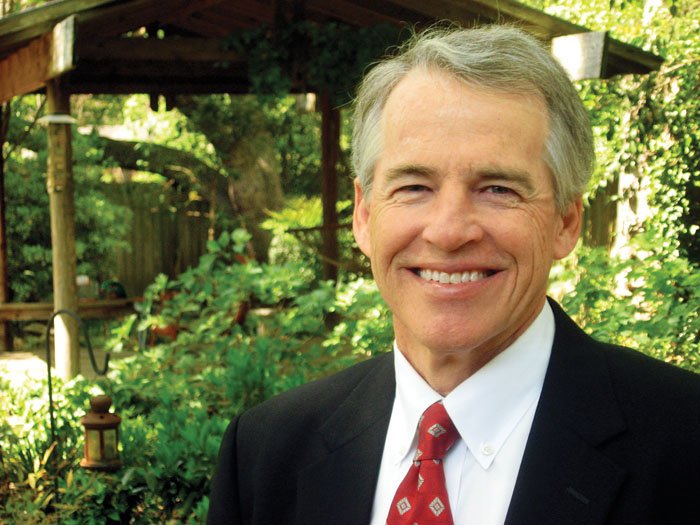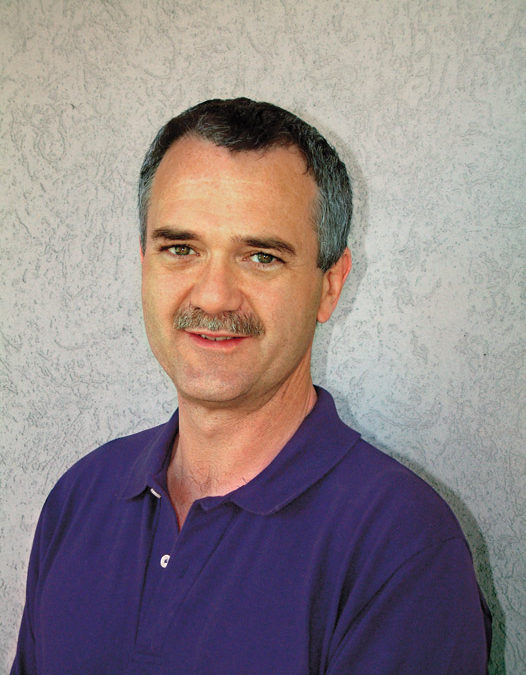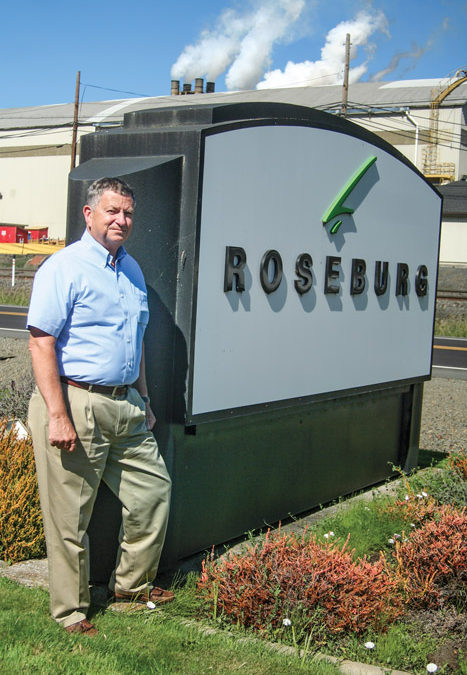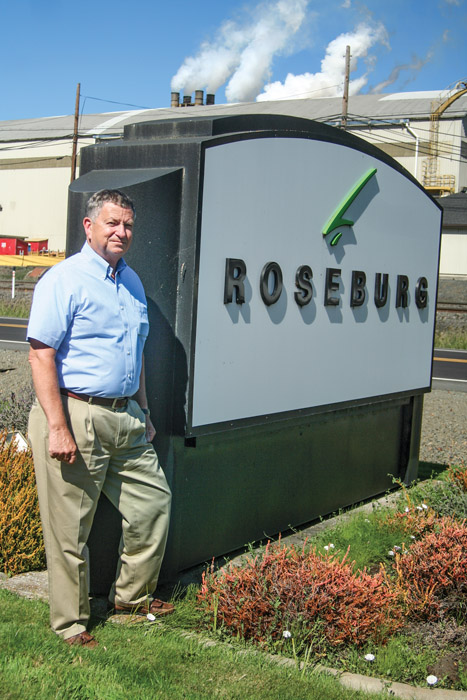
by Web Editor | Oct 25, 2013 | Taking Stock
They Were The Best And The Brightest
 Article by Rich Donnell, Editor-in-Chief, Panel World 2013
Article by Rich Donnell, Editor-in-Chief, Panel World 2013
On page 8 we report on the death of Gene Knokey, who during his era was one of the most brilliant plywood machinery men in the industry. And it was a long era, extending from post-World War II to 2000, some 50 years, during which he went from building and managing several plywood plants in the Northwest to becoming one of the main innovators at Coe Manufacturing.
Knokey, who worked with his equally innovative dad in the early years, was very much involved in the design of the X-Y charger and all the other constant improvements done to the lathe. He along with Art McGee at Coe and Harold Erickson of Weyerhaeuser were instrumental in the development of the core drive for log stability as it was peeled.
The story is told that Coe put one in at Weyerhaeuser’s plant in Longview, Wash. with the understanding that if it worked, Coe would build the next 10 for Weyerhaeuser. Coe put it in and it worked, but Weyerhaeuser wouldn’t buy the next 10. For a while Weyerhaeuser wouldn’t let Coe sell it to anyone else, until finally relenting. After Coe sold a lot of them, Weyerhaeuser came back and said they were supposed to have the rights to them, and Coe’s Fred Fields and Knokey, who were always on top of their legal game, responded that Weyerhaeuser had the rights to buy as many as they wanted, but they didn’t have the rights.
You can google-search patents for Knokey and several will come up, but Coe owner Fields once told me he often put the names of employees on the patents who perhaps were not as involved in the invention as some others in order that these employees would feel better about themselves and their stake in the company. Fields said Knokey probably had twice as many as he was officially given credit for.
One of my fondest memories during my 30 years writing about this industry was attending the old Portland machinery show in Oregon and stopping by the Coe booth, where the likes of Fred Fields, Gene Knokey, Ralph Gage, Art McGee and a young Alan Knokey were always holding court. You had better have your wits about you when you sat down with that group, as the conversation fluctuated from Nosler’s laser scanning on lathe chargers to college football in the 1950s in a heartbeat.
Indeed there was a lot of camaraderie and technology innovation and exchange between the likes of Knokey and various mill company engineers. I mentioned Harold Erickson at Weyerhaeuser, one of the company’s top engineers in the days when Weyerhaeuser had more than a thousand of them. Erickson died fairly young in 1973, so I never had the privilege of meeting him, but from what I’ve discovered he’s probably in the top 10 of plywood technology innovators if anybody keeps such a list.
Knokey is in that list, too. I didn’t get to know him as well as I knew Fields, but he was always friendly and willing to answer any questions on plywood technology. For me, those brief exchanges with one of the men who inspired and created plywood technology as we know it, will be forever cherished. These were men who knew they were in the middle of something special and labored with devotion pretty much around the clock.
The monthly Panel World Industry Newsletter reaches over 3,000 who represent primary panel production operations.
Panel World is delivered six times per year to North American and international professionals, who represent primary panel production operations. Subscriptions are FREE to qualified individuals.
Complete the online form so we can direct you to the appropriate Sales Representative. Contact us today!

by Web Editor | Sep 6, 2013 | Taking Stock
Story by Rich Donnell,
Editor-In-Chief
The latest development in EPA’s proposed formaldehyde regulations is that Composite Panel Assn. and the Federal Wood Industry Coalition filed a petition with the EPA asking for an extension of the public comment time beyond what EPA had granted, due to the complexity of the proposed rules.
EPA’s proposed rules fundamentally align with the requirements for composite wood products set by the California Air Resources Board (CARB), putting in place national standards for companies that manufacture or import hardwood plywood, MDF and particleboard. EPA’s proposals also encourage switching to no-added formaldehyde resins.
Some of the concerns on industry’s part include the disclosure of confidential business information, the handling of non-complying lots, definitions of hardboard and laminated products for purposes of exemption, treatment of ULEF and NAF, and various obligations of third party certifiers.
CPA has favored national standards to level the playing field, but if it needs more time, so be it. After all, the formaldehyde emissions issue has been with us for more than three decades, and even longer if you go back to the early 1970s; that’s when the technical director of National Particleboard Assn. (which became CPA) called up the NPA legal counsel and said somebody had raised the question about whether the off-gassing of formaldehyde was something individual companies should be concerned about because it might violate the federal law that prohibited shipment of chemicals or items that might cause chemical-related problems. NPA chose to send out a notice to its member companies giving them a heads-up.
The issue really took hold in the late 1970s, when some manufactured home occupants complained about irritation; also, a study by the Chemical Industry Institute of Technology found high levels of inhaled formaldehyde (15.0 ppm-parts per million) for a two-year period caused nasal cancer in lab rates; and Consumer Products Commission investigated a few installation problems with urea formaldehyde foam insulation in retrofit projects in older homes, generating widespread media coverage.
As CPA is today, it was then highly proactive along with the adhesive suppliers, and by the mid 1980s product emissions had been reduced by more than 75%.
EPA first jumped into the fray in 1983, looking at worst-case scenarios and suggesting home occupants could develop cancer, though numerous independent studies kept indicating such evidence was lacking.
In the mid 1990s, NPA even put up nearly a half million dollars toward the construction of a test home, and the ensuing studies showed formaldehyde levels lower than what the EPA models had predicted. In the test house as a whole, formaldehyde concentrations did not exceed .070 ppm, and the highest level was .076 ppm in the kitchen.
Today’s CARB regulations and those proposed by EPA call for 0.09 ppm for particleboard, 0.11 for MDF and 0.13 for thin MDF, as well as 0.05 ppm for hardwood plywood with veneer or composite core. EPA should thank the composite board industry for its amazing accomplishments.

by Web Editor | Jun 17, 2013 | Taking Stock
Story by Dan Shell,
Managing Editor
The U.S. Environmental Protection Agency (EPA) recently released the agency’s proposed regulations for the first national standard for formaldehyde emissions from composite wood products. The move is required under the Formaldehyde Standards for Composite Wood Products Act that was signed into law in 2010. The proposal’s release sets up a public comment period on the potential regulations that runs through early August.
The new regulations prescribe how much formaldehyde may be emitted from hardwood plywood, medium density fiberboard, particleboard and finished goods made from those products. As noted in the news article on page 6, the EPA’s proposed rules cover two main areas: the definitions of formaldehyde emissions limits and the procedures for implementing them, and also the structure and responsibilities of Third Party Certifiers (TPCs) that will do most of the documenting of producer compliance with the new regulations.
In developing its response through the public comment process, Composite Panel Assn. is working with the Federal Wood Industries Coalition that includes APA—The Engineered Wood Assn., Hardwood Plywood & Veneer Assn., American Forest & Paper Assn. and additional trade groups from the furniture, millwork and chemical industries.
When the federal legislation underpinning the proposals was enacted in 2010, it was promoted as a way to develop a national standard for formaldehyde emissions from composite panel products, giving producers a level of certainty and relieving them from having to work with multiple state agencies and the feds to ensure products are in compliance.
The legislation and plan in 2010 was to adopt national formaldehyde regulations that had been implemented by the California Air Resources Board (CARB), which had adopted stringent emissions limits that went into effect in January 2009. The move was heralded as an issue where competing interests could work together.
Among the concerns CPA has listed with the initial EPA proposals are issues with the TPC process, including EPA recognition that will need to be synced with CARB system, and also record-keeping requirements for TPC testing and even EPA’s treatment of non-complying product lots, which CPA would like to see consistent with CARB practices.
The concept of creating a level playing field and avoiding a proliferation of laws and regulations depending on jurisdiction and marketplace is an admirable one. Then again, it’s easy to see the temptation on the part of EPA to put its own signature on the regulations and to develop a “better” version of the CARB regulations. But changing the substance of CARB’s regulations would betray the process that all sides committed to in 2010. Here’s to hoping EPA keeps its eye on what everybody else has already figured out.

by Web Editor | Apr 10, 2013 | Taking Stock
Story by Rich Donnell,
Editor-in-Chief
One of the comments I continued to hear from many industry professionals as we waded through the muddy recession together and as new housing starts sank to 500,000 annually (and even lower, but I couldn’t bear to watch anymore), was “just wait until we reach 1 million housing starts again. It’ll seem like 2 million!”
The point being that a doubling of housing starts would create such euphoria in manufacturing that 1 million might as well be 2 million. Everybody would be so delighted at the increased business, and running so hard in their business (and so unaccustomed to being so busy) that nobody would have time to pay attention to 1 million, or 2 million.
Well, are you starting to feel that way yet?
Among other things, our report in this issue on the domestic composite panel industry beginning on page 22 reveals several of the latest housing forecasts and all of them top 900,000 for 2013, followed by an increase to more than 1 million in 2014. Indeed these forecasters have been adjusting their figures slightly upward with some regularity.
I must say that we as a publisher of magazines in the building products industry have been busier as of late. Your activities, or lack thereof, in the mills and in equipment manufacturing shops trickle down, for better or worse, to us, just as new housing or no housing trickles down to you. Right now, it’s for the better. It’s easy for us to quickly research what years were better or worse. We simply go into our library, look at the annually bound issues, and can tell by the thickness of those bound volumes. The thicker the year the better, meaning more pages per issue, more advertisements, more articles.
However, I’m going to stop short of announcing that today we should be euphoric. And I’m guessing that most of you are in agreement with me.
(Then again, those who have not been in this industry for very long, say for just a handful of years, perhaps are feeling euphoric. Perhaps 1 million might as well be 2 million, compared to when they joined the industry, when it was 500,000. They’re too young to know any better.)
But for most of us, and especially for the ones of us who’ve been around a long time, say 30 years or so, this should not be euphoria. One million housing starts is what it says it is, 1 million, not 2 million. We can remember when 1 million housing starts was not very good; that it was an indicator of recessionary times; our bound volumes of magazines were not very thick in those years of 1 million.
And so to go back to the premise of this column, our friends may have been overstating it a bit when they said 1 million would seem like 2 million. Not to take anything away from the 500,000 where we were to the 1 million we’re now entering. The latter is certainly more enjoyable than the former. New projects. More jobs. Renewed spirit. Thicker magazines. No small matters, those. But, no, it’s not 2 million. You’ll know 2 million when it comes again. There will be no mistaking it. And you’ll say 1 million couldn’t hold a candle to 2 million.
Here’s to 2 million!

by Web Editor | Feb 18, 2013 | Taking Stock
Story by Dan Shell,
Managing Editor
This issue confirms two trends in the forest products industry: The U.S. housing market is finally showing significant improvement after the most drastic drop in history; and the reliance of Europe and the UK on energy wood fiber from the Southeastern U.S. is continuing to increase as reflected in new wood pellet plants announcements.
Several years after falling off a cliff starts-wise, the housing market is showing true signs of life, with activity picking up throughout 2012 and momentum carrying into this year. Prices for OSB almost doubled in 2012 and remain strong in first quarter 2013.
As noted in the cover story on page 12, the OSB segment of industry played it cautious last year as positive economic signals increased. But by the end of 2012 several OSB producers announced plant reopenings and startups in 2013, and others were taking a close look at adding shifts or otherwise increasing production.
Meanwhile, the feature article on page 16 details an exciting time in the wood-based energy industry: Increased usage of U.S.-sourced wood fuel pellets by UK and European power producers has gained increasing momentum in the past three to four years, doubling from 2009 to 2012 and is expected to double again by 2020 (if that long). In 2012, the U.S. surpassed Canada to become the world’s largest wood fuel pellet exporter.
According to a report from the University of Georgia School of Forest Resources presented to Southern landowners a year ago, there were 29 operating wood fuel pellet mills in the region, most of them targeting the European export market. From there, Southern industrial pellet capacity is set to double through 2014, as the last round of new plants announced the latter half of 2012 average more than 400,000 tons annual production capacity.
The rise of such a forest fuel industry makes for unprecedented dynamics in timber supply, as companies more allied with the energy market than traditional forest products markets compete for their share of raw materials.
Pulp and paper producers, wood fuel pellet mills and OSB plants all compete for the same log, and while the housing picture and overall economy has a good ways to go to truly heat up any procurement competition among the three, the potential is there for issues to arise in wood baskets where all three are strong players.
At last year’s Bioenergy Fuels & Products Conference & Expo held in conjunction with the Panel & Engineered Lumber International Conference & Expo in Atlanta, forester Dean McCraw of McCraw Energy noted two misconceptions that many have: the Southern U.S. pulp and paper industry is going away; and that there’s a “wall of wood” in the U.S. South that will supply all users.
He added that the timber base can be tough to navigate: A big issue is the changing dynamics of timberland ownership and the rise of timber management investment groups that tend to manage for sawtimber instead of pulpwood.
To ensure adequate raw material supply, OSB producers should establish strong and long-term relationships with pulpwood suppliers—and be well aware that one characteristic of wood fuel pellet plants and biomass power producers are long-term raw material supply arrangements that are attractive to loggers and other timber suppliers.
Depending on your location and wood basket, unprecedented timber dynamics and new players in the market will require more focused, long-term raw material planning.

by Web Editor | Dec 27, 2012 | Taking Stock
‘Pure Agony, Pure Joy, Nothing In Between’
Article by Rich Donnell, Editor-in-Chief, Panel World (2012)
 As usual, APA’s annual meeting was an enlightening and festive affair, held on Amelia Island, Florida. Keynote speaker and financial analyst Ron Insana gave everybody reason for hope (see page 66), but the real treat in my book was the brief talk given by Allyn Ford, president and CEO of Roseburg Forest Products.
As usual, APA’s annual meeting was an enlightening and festive affair, held on Amelia Island, Florida. Keynote speaker and financial analyst Ron Insana gave everybody reason for hope (see page 66), but the real treat in my book was the brief talk given by Allyn Ford, president and CEO of Roseburg Forest Products.
APA presented Ford the 2012 Bronson J. Lewis Award for leadership and outstanding contribution to the engineered wood products industry. Ford has served as president and CEO of Oregon-based Roseburg Forest Products since 1997, assuming the role after the death of his father, founder Kenneth Ford. Roseburg Forest Products is one of the largest producers of softwood and hardwood plywood and LVL/I-joist. Ford and his wife Cheryl’s philanthropic and charitable endeavors are too many to list here.
Speaking of the industry, Ford said, “It’s a very special fraternity, a very different group of people. We suffer through these cycles, pure agony, pure joy, nothing in between. These extremes create a different type of culture, thick skin, stubborn, but also (a sense of) humility.”
Ford noted that he has made a lot of mistakes, but that you can’t sit still, and you continue to “bet the farm” every cycle. He said he’s been through six such cycles.
Regarding the latest one, Ford said, “The great recession has been painful. It’s left a few scars. But (now) we have a recovery. We’re seeing (positive) changes in the economy and certainly in our industry.”
Meanwhile, Ford said, “The restructuring of our industry, a new generation coming on…This is a time of great opportunity.”
Ford asked aloud, “Why don’t I retire?” He answered, with a smile, that he feels tremendous satisfaction in being able to say he owns a wood product business that has surpassed 75 years in longevity. “We can still shake hands and cut a deal,” he said. “There’s great faith and honesty in our industry.”
When Ford said, “it’s been fun,” I became concerned that he was about to say he was bowing out. But he followed with, “I’ve got two or three years left, much to the disappointment of my managers (at Roseburg).”
It troubles me when industry loses its great people to retirement. Maybe we can convince Ford to put in another 10.
RELATED ARTICLES
2020 APA SAFETY AND HEALTH AWARD WINNERS ANNOUNCED
APA SELECTS NEW PRESIDENT
APA NAMES NEW DIRECTOR OF QUALITY SERVICES
The monthly Panel World Industry Newsletter reaches over 3,000 who represent primary panel production operations.
Panel World is delivered six times per year to North American and international professionals, who represent primary panel production operations. Subscriptions are FREE to qualified individuals.
Complete the online form so we can direct you to the appropriate Sales Representative. Contact us today!

 Article by Rich Donnell, Editor-in-Chief, Panel World 2013
Article by Rich Donnell, Editor-in-Chief, Panel World 2013



 As usual, APA’s annual meeting was an enlightening and festive affair, held on Amelia Island, Florida. Keynote speaker and financial analyst Ron Insana gave everybody reason for hope (see page 66), but the real treat in my book was the brief talk given by Allyn Ford, president and CEO of
As usual, APA’s annual meeting was an enlightening and festive affair, held on Amelia Island, Florida. Keynote speaker and financial analyst Ron Insana gave everybody reason for hope (see page 66), but the real treat in my book was the brief talk given by Allyn Ford, president and CEO of